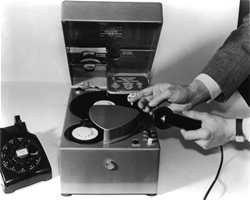In the U.S., the telephone company’s response to the growing customer demand for answering machines was to introduce live answering services. These consisted of a special switchboard and circuitry that allowed human operators to provide a sort of “call forwarding.” Live answering services (which are still available today) were popular among small businesses and professionals, such as doctors, who ran small offices.
However, the success of the answering services stimulated inventors to develop even more new answering machines. Under pressure from these inventors and from electronics manufacturers, the U.S. Federal Communications Commission (which regulated the telephone industry) for the first time over-rode AT&T’s internal policy restricting the use of automatic answering machines, at least on the long distance lines, which were considered separate from the local circuits.
AT&T complied, but it strongly encouraged its subsidiaries, the local operating companies, to maintain tight restrictions on what types of answering machines could be offered to customers, and how they could be used.
AT&T announced that it would test the “Peatrophone” (see above) answering machine made by Gray Manufacturing Company as its first official consumer offering. Gray was a maker of telephone equipment, and was related to the current Graybar Corporation.
The first tests were made in the Ohio Bell system, and AT&T made Peatrophones available to all customers by 1951. The Peatrophone’s design included small phonograph disc that held the outgoing message, and a larger disc was used to capture the incoming calls. Extra disks were stored in the lid.

